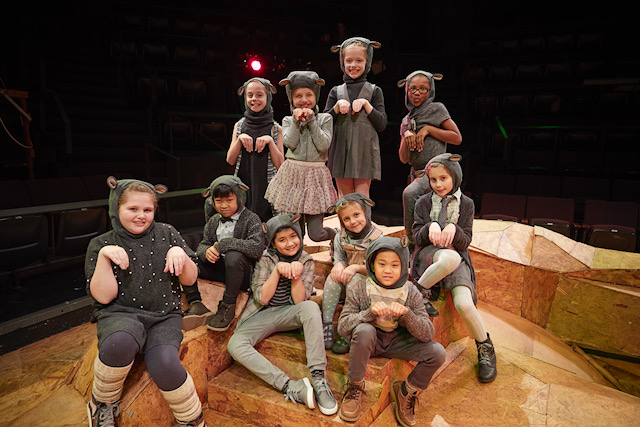
Sensory friendly or “relaxed” performances have increasingly become a part of any company’s accessibility program, but creating an inclusive experience through a relaxed performance can be intimidating. After we began doing sensory friendly performances at Actors Theatre of Louisville, I’ve been asked how I engaged designers and technicians with relaxed performances.
Some managers who reached out to me had been having some miscommunications with their production staff, who wanted to support sensory friendly programming but were wary of making changes to predetermined designs or didn’t understand how relaxed performances would impact their work. To those production team members, I would have said the following:
Creating a welcoming and relaxed environment that is encouraging and warm is THE most important thing you can do to make these performances a success. Full stop. Engage people with sensory sensitivities (Autism, PTSD, epilepsy, etc.) and other dis/abilities as consultants, staff or volunteers, so that you’re gaining their viewpoint and experience in advance. You may not see any patrons the day of the show, but if you do, be extra friendly, introduce yourself, and stay calm. Marketing, box office, our front of house, and education staff at Actors Theatre as well as our production team make our sensory friendly performances possible and their insights help guide all of our accessibility programming. If your organization doesn’t have equipment, training, or contacts to support these performances, reach out to someone in your area who has and learn from them. The VSA, an international arts and disability advocacy group, was a great resource for us, as was the Kentucky Autism Training Center and Talleri McRae, an inclusion/access specialist.
Patrons coming to sensory friendly performances, in my experience, want to have similar experiences to the patrons who attend our other performances. The goal isn’t to make wholesale changes to the production wantonly, but to make only the absolutely necessary adjustments to the designs.
You can cut the strobe lightning and lower the thunder level in King Lear while still letting the rest of the scene convey the intensity of the storm.
There is no doubt that makes the editing of the design very subjective, which is why ideally your designers are the ones making those choices. Better yet if they can make those adjustment decisions in advance of the day of the sensory friendly performance. If that’s not possible with the limitations of tech time or designer involvement, make the best judgments you can for the particular performance with your designers’ blessings and move forward. You will learn, and your patrons will get to experience art. Win-win.
As our team prepared for Little Bunny Foo Foo at Actors Theatre of Louisville, we talked about the fact that we were doing a sensory friendly performance of the show at every design and production meeting we had. Interdepartmentally, we talked about what materials production and marketing would need to develop for ourselves and for our patrons, such as an “Arrival Guide” to help our patrons understand how to get from their parking spot to their seats, and a study guide for the play that helped break down how the world of the play would be represented in our production. We discussed what makes for a “jarring moment,” and we worked with the education department and front of house to lay out a plan for how we would alert our audience members to those jarring moments during the show. We shared information about the sensory friendly performance during rehearsals with the actors, and the day of the relaxed performance the cast talked again about how they may or may not change the audience interaction components of the show.
Talking about it made it less intimidating, less confusing, and ultimately something everyone was excited about when the time came for it.
The sensory friendly performance of Little Bunny Foo Foo at Actors Theatre of Louisville was a singular experience for me.
It was the most joy I’ve ever seen in our theatre and not just due to the enthusiastic spirit of the children in the audience.
Parents who could watch their kids being kids at the theatre clapped along to the music and laughed at the antics of our forest-dwelling characters. Relaxing the theatrical norms about getting up during the performance, talking, eating and playing makes for a liberated experience that I honestly think is better for everyone.

If you haven’t put on a sensory friendly performance, I’d really encourage you to go to one, not to learn how it’s done, but to see the way communities of all stripes are brought together by a love of theatre and a need to be themselves while watching it. It’s beautiful.
I know it’s kind of cheating to say you have Five Things and then the fifth thing is actually 15 things, but I’d be remiss without including a list of the practical elements that I’ve used and seen used. None of these are required though, so please don’t wait until you have absolutely all of these to move forward:
Want To Have A Theatre Career? 6 Tips To Get You Started.
Unconscious Bias: Have You Addressed Yours?


Michael DeWhatley is the associate production manager at Actors Theatre of Louisville and serves on the board of CenterStage at the Jewish Community of Louisville as well as the board of Theatre [502]. He has previously worked as the Production Manager at the Kentucky Shakespeare Festival. He was also employed in general management at the Berkshire Theatre Group and in production at Lexington Children's Theatre and Shenandoah Summer Music Theatre. In addition to his work in production and management, he has worked as a directing assistant on projects at Actors Theatre of Louisville and the Berkshire Theatre Group and is a freelance contributor to HowlRound.
Read Full Profile© 2021 TheatreArtLife. All rights reserved.

Thank you so much for reading, but you have now reached your free article limit for this month.
Our contributors are currently writing more articles for you to enjoy.
To keep reading, all you have to do is become a subscriber and then you can read unlimited articles anytime.
Your investment will help us continue to ignite connections across the globe in live entertainment and build this community for industry professionals.